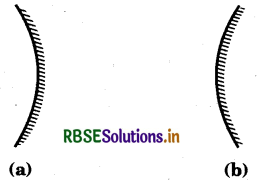RBSE Class 7 Science Notes Chapter 15 Light
These comprehensive RBSE Class 7 Science Notes Chapter 15 Light will give a brief overview of all the concepts.
Rajasthan Board RBSE Solutions for Class 7 Science in Hindi Medium & English Medium are part of RBSE Solutions for Class 7. Students can also read RBSE Class 7 Science Important Questions for exam preparation. Students can also go through RBSE Class 7 Science Notes to understand and remember the concepts easily. The class 7 science chapter 4 heat extra questions are curated with the aim of boosting confidence among students.
RBSE Class 7 Science Chapter 15 Notes Light
→ Light travels along a straight line.
→ The surface of water can also act like a mirror and change the path of light.
→ A mirror changes the direction of light that falls on it. This change of direction by a mirror is called reflection of light.
→ An image formed by a plane mirror is erect and of the same size as the object.
→ In an image formed by a mirror, the left side of the object is seen on the right side of the image, and the right side of the object appears to be on the left side in the image. This phenomenon is known as lateral inversion.

→ If the reflecting surface of a spherical mirror is concave, it is called concave mirror. If the reflecting surface is convex, then it is a convex mirror.

(a) A concave and (b) a convex mirror
→ The image formed by a concave mirror can be smaller or larger in size than the object. The image may also be real or virtual.
→ The image formed by a convex mirror is erect, virtual and smaller in size than the object.
→ A convex lens can form real and inverted image. When the object is placed very close to the lens, the image formed is virtual, erect and magnified. When used to see objects magnified, the convex lens is called a magnifying glass.
→ The image formed by a concave lens is always virtual, erect and smaller in size than the object.
→ A convex lens converges (bends inwards) the light generally falling on it. Therefore, it is called a converging lens. On the other hand, a concave lens diverges (bends outwards) the light and is called diverging lens.
→ The white light consists of seven colours.
→ The band of seven colours formed on a white screeen, when a beam of white light is passed through a glass prism, is known as spectrum of white light.

- RBSE Class 7 Science Notes in Hindi & English Medium Pdf Download
- RBSE Class 7 Science Important Questions in Hindi Medium & English Medium
- RBSE Solutions for Class 7 Science in Hindi Medium & English Medium
- RBSE Class 7 Science Important Questions Chapter 1 Nutrition in Plants
- RBSE Class 7 Science Notes Chapter 1 Nutrition in Plants
- RBSE Class 7 Science Important Questions Chapter 14 Electric Current and its Effects
- RBSE Class 7 Science Important Questions Chapter 13 Motion and Time
- RBSE Class 7 Science Important Questions Chapter 2 Nutrition in Animals
- RBSE Class 6 Science Notes Chapter 8 शरीर में गति
- RBSE Class 7 Science Notes Chapter 18 Wastewater Story
- RBSE Class 7 Science Notes Chapter 17 Forests: Our Lifeline